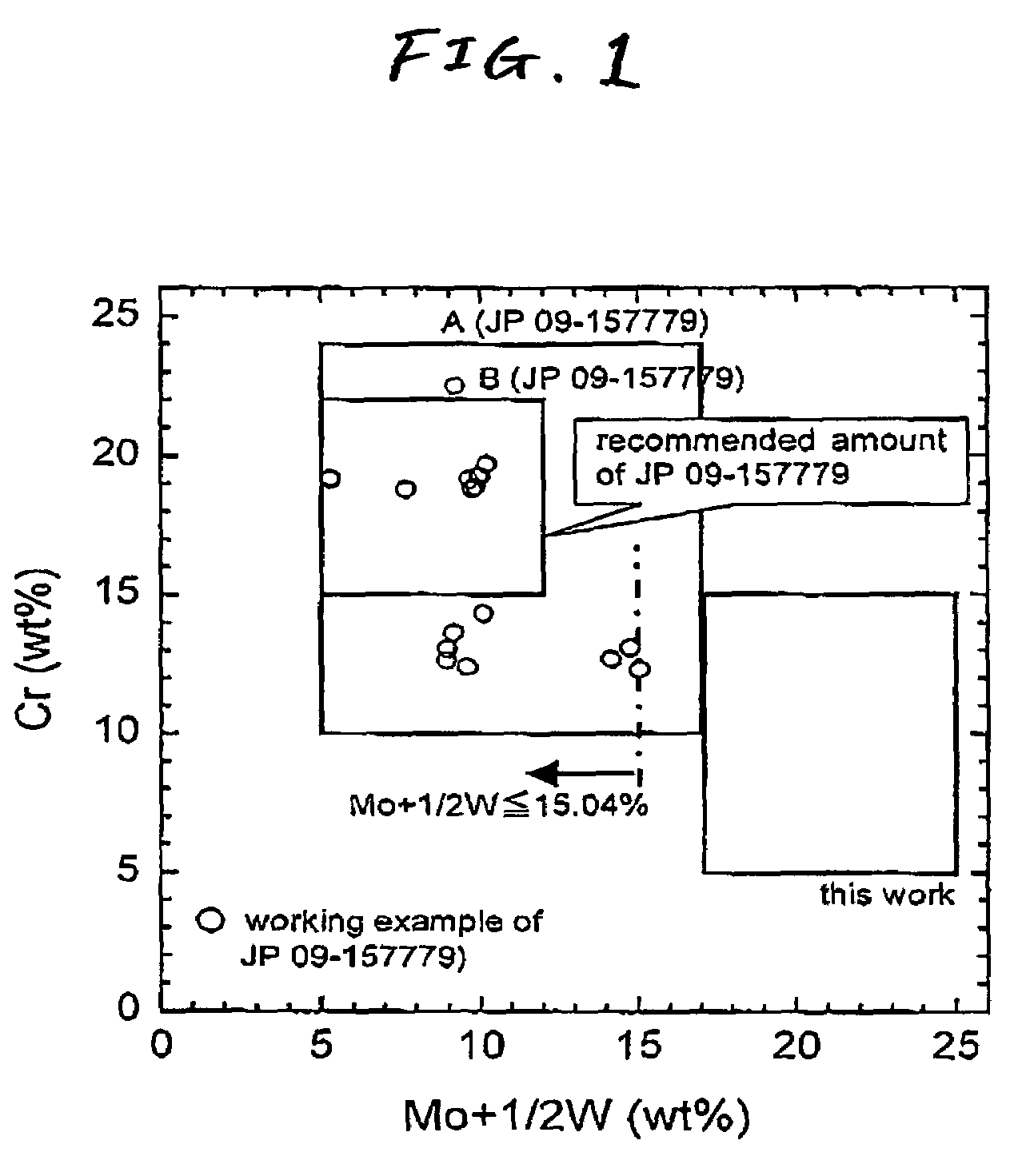Low thermal expansion Ni-base superalloy
a superalloy and low thermal expansion technology, applied in the direction of physical/chemical process catalysts, metal/metal-oxide/metal-hydroxide catalysts, chemistry apparatuses and processes, etc., can solve the problems of thermal fatigue, low strength of materials at high temperature, and leakage of steam
- Summary
- Abstract
- Description
- Claims
- Application Information
AI Technical Summary
Benefits of technology
Problems solved by technology
Method used
Image
Examples
examples
[0034]Various examples of the present invention will be explained below.
[0035]The alloy components having the compositions as shown in Table 1 was melted in a vacuum induction furnace having a capacity of 50 kg and an ingot weighing 50 kg was cast. The surface of an ingot was cut away and the ingot was heat-treated for 15 hours at 1150° C. as a homogenizing treatment. Thereafter, the ingot was forged into bars each having 60 mm square. The forged bars were heated for 2 hours at 1100° C., and thereafter water-cooled for its solid solution. The bars were subjected to hardening treatment aging for 16 hours at 750° C. Sample pieces cut from the bars were subjected to various tests. Thus, the test results as shown in Table 2 were obtained.
[0036]As regards the thermal expansion coefficient, using quartz as a standard sample, the average thermal expansion coefficient from room temperature to 70° C. was measured by a dilatometer available from RIGAKU DENSI CO. LTD. The measurement was carri...
example no.1-b
Example No. 1-B
[0050]The alloys having the compositions as shown in Table 3 was melted in a vacuum induction furnace having a capacity of 50 kg, and its ingot having 50 kg was cast. The surface of an ingot was cut away and the ingot was heat-treated for 15 hours at 1150° C. as a homogenizing treatment, and then the ingot was forged into bars each having 60 mm square. The thus forged bars were subjected to a solution treatment by heating them for 2 hours at 1100° C. and then water-cooling. By carrying out three heat treatments of the alloy, namely y′ phase precipitation heat treatment (750° C.×24 hr / AC), A2B phase precipitation heat treatment (650° C.×24 hr / AC) and a heat treatment for precipitating both of the y′ phase and A2B phase (750° C.×24 hr / AC+650° C.×24 hr / AC), tensile test at 700° C. and measurement of thermal expansion coefficient from room temperature to 700° C. were carried out.
[0051]As regards the thermal expansion coefficient, using quartz as a standard sample, the ave...
example no.1-d
Example No. 1-D
[0055]The alloy shown in Table 5 was subjected to melting, forging and solution treatment by the same method of example No. 1-B, and a heat treatment for precipitating the γ′ phase and A2B phase was carried out as shown in Table 6. In this connection, the alloy of example No. 6-D is a case in which the precipitation of γ′ phase and A2B phase was carried out at same time under a condition of 700° C.×24 hr / AC. Also, for the Invar alloy Inconel 783 and Incoloy 909 of comparative example Nos. DC 5 and DC 6, heat treatments of 1015° C.×1 hr / WC+840° C.×3 hr / AC+720° C.×8 hr→(cooling speed 56° C. / hr)→620° C.×8 hr / AC and 980° C.×1 hr / WC+720° C.×8 hr→(cooling speed 56° C. / hr)→620° C.×8 hr / AC were respectively carried out.
[0056]On these alloys, thermal expansion coefficient measurement, high temperature tensile test, creep rupture test and steam oxidation test which is problematic in a steam turbine member were carried out. The thermal expansion coefficient measurement and high ...
PUM
| Property | Measurement | Unit |
|---|---|---|
| temperature | aaaaa | aaaaa |
| temperature | aaaaa | aaaaa |
| diameter | aaaaa | aaaaa |
Abstract
Description
Claims
Application Information
 Login to View More
Login to View More - R&D
- Intellectual Property
- Life Sciences
- Materials
- Tech Scout
- Unparalleled Data Quality
- Higher Quality Content
- 60% Fewer Hallucinations
Browse by: Latest US Patents, China's latest patents, Technical Efficacy Thesaurus, Application Domain, Technology Topic, Popular Technical Reports.
© 2025 PatSnap. All rights reserved.Legal|Privacy policy|Modern Slavery Act Transparency Statement|Sitemap|About US| Contact US: help@patsnap.com

